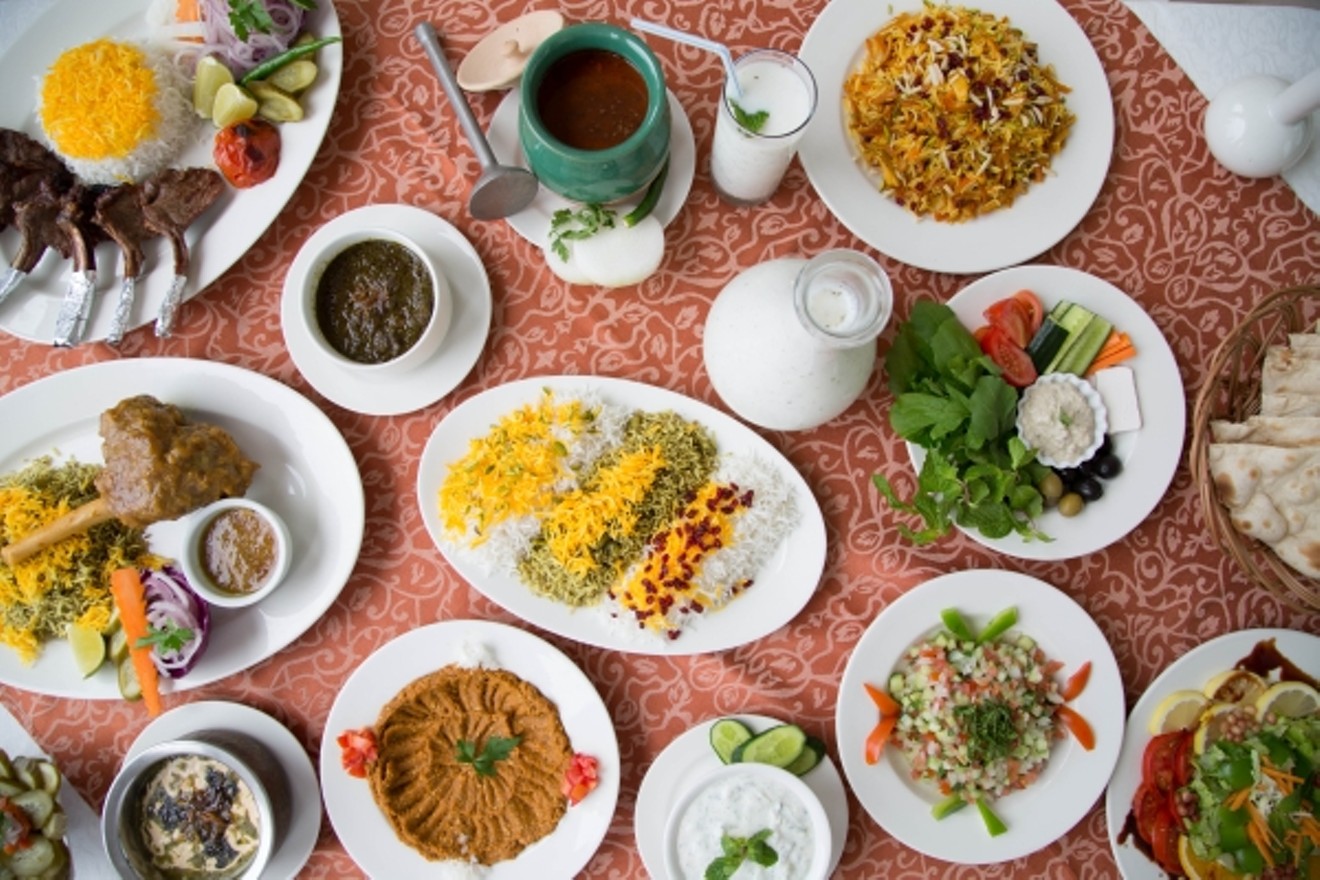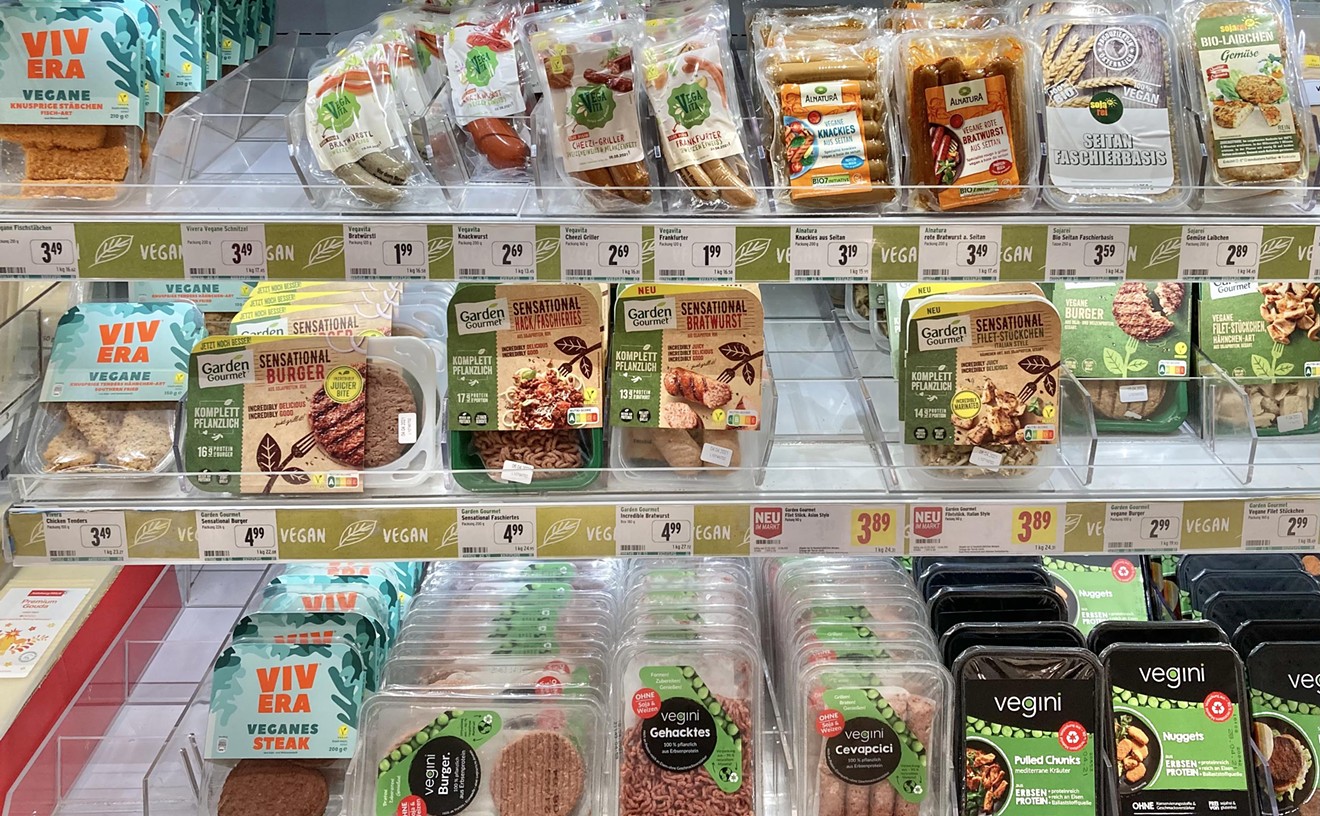Cuisine: Persian/ Iranian
Restaurant Name Keywords: Persian, Caspian, Iranian, Pars
Menu Keywords: Kashk, Doogh, Koobideh, Ghormeh, Polo
What is Persian Food?
Persian cuisine is the food of Iran, one of the most ancient civilizations on earth. The Persian canon of dishes reflects the wide reaches of the long-ago empire in both their sophistication and diversity.
Iranian dishes rely on a bounty of high-quality herbs, fresh vegetables, dried fruit, and good cuts of meat, rather than on spices, for their flavor, so the relatively mild dishes tend to be easy for almost anyone to enjoy. Never piquantly spicy, most are seasoned simply with salt, pepper, and fresh herbs in order to let the star ingredients shine. That said, on every Iranian table, you will find a bottle of tangy, citrusy red sumac powder to add the perfect finishing touch to kebabs and rice dishes.
Persian cuisine is often lumped together in the broad category of "Middle Eastern," along with the Lebanese, Syrian, Turkish, and Egyptian restaurants whose menus feature familiar Mediterranean flavors like tahini, chickpeas, parsley, and pita bread, and staple dishes like falafels, hummus, and shawarma.
Confusingly, many Persian restaurants have also added these Levantine dishes to their menus, often along with Greek salad (I can only assume based on customer requests), but when you go out for Iranian, forgo the popular Lebanese roasted eggplant dish babaghanoush and instead try kashk e badamjan, a roased eggplant dip mixed with rich dehydrated yogurt and topped with fried onions and mint leaves. Instead of falafel, order tadig, crisp-fried rice served under a thick blanket of the herb and lamb stew called gormeh sabzi.
But wait. With all these sneaky pan-Arabian dishes sneaking onto Persian menus, how will you know you've actually found yourself an Iranian restaurant? Check the menu. If it contains some, or all, of the essential Iranian dishes listed below, then you are in the right place, as you will never find these specialty dishes on a pan-Middle Eastern menu.
Beyond that, start your journey with one of these four Iranian gems:
Pars Persian Cuisine, Scottsdale
Go for: the absolute best selection of Persian dishes in Phoenix. From tadig to the celebratory sweet rice, shirin polo, they have pretty much everything except deezee, and one of the best koobideh kabobs in town.
Persian Room, Scottsdale
Go for: excellent grills, including barg (filet), chicken, and the classic koobideh, along with a wide selection of stews and rice dishes.
AZ Kabob, Scottsdale
Go for: Deezee. This fast casual spot next to the movie theater is the only place in town that serves it. Their koobideh kabob is also very good.
Caspian Market, Scottsdale
Go for: fresh-baked sangak and barberri bread, bottles of doogh, and Iranian ingredients like sour pickles (torshe), barberries, fresh goat cheese, Persian clotted cream, and even hard-to-find Persian produce.

A Persian feast of fessenjan, ash e reshteh, tadig, kashk e bademjan, mast o moseir, doogh, mixed kebabs, and rice at Pars Iranian Restaurant in Scottsdale.
Mehdi Taghavi (architect-mehdi.com)
Tips: Farsi uses a different alphabet, so don't be surprised to see the Romanized names of dishes spelled different ways at different restaurants. If it sounds similar, it is likely the same dish, just spelled a different way. Beyond the appetizers, many of which are yogurt-based dips, the two main categories you will find on a Persian menu are stews and grills, which can be eaten with either bread or rice, or both. It is best to go with a group so you can order several dishes to be shared family-style.
STARTERS
Fresh Herbs and Bread: If you are at a sit-down restaurant, your meal should begin with a plate of complimentary fresh herbs, raw onion, fresh cheese, and a thin, chewy flatbread called sangak or its thicker, sesame-seeded counterpart, barbari. The herbs, onion, and cheese should be wrapped in pieces of flatbread. For some reason, all the Persian restaurants we have found here in Arizona serve their herb and bread setup with warm, pita-like bread and pats of butter instead of cheese. It is still wonderful eaten along with a thick, creamy Persian dip, but for the real deal, go buy some fresh bread and feta cheese from the Persian market.
Ash e Reshteh: This hearty soup is sold on the roadside in the cold mountains north of Tehran, and is like an amped-up, super-herbaceous noodle soup. Short pasta noodles, beans like pinto, kidney, and garbanzo, spinach, fresh herbs like parsley, cilantro, and chives, and chopped garlic cook long and low. The resulting soup is topped with tangy kashk (yogurt whey), fried mint, and fried onion for a dish that is complex to make, yet yields simple, comforting results. It is best enjoyed with a squeeze of lemon or lime just before eating.
Kashk e Bademjan: For this dish, eggplant is roasted and blended with kashk (yogurt whey) and ground walnuts, then topped with fried mint and onion for a thick, creamy dip with a slight sweetness and slight bitterness that is great slathered on warm flatbread.
Maust o Moosier: Simply a blend of fresh yogurt and shallot or garlic, this classic dish is minimalist perfection. It is best enjoyed layered on a piece of flatbread with a slice of raw onion, which becomes sweet under the foil of the yogurt. It is also great alongside many of the hearty rice dishes.
Tadig: This is not a dish in and of itself, but instead an element of an Iranian polo (rice dish). Traditionally, when a polo (rice) is cooked, the bottom of the pot is oiled and the cooked over a higher flame to allow the bottom layer of rice to become crisp, while the rest of the rice steams to tender perfection. At home, the crispy bottom, called tadig, is often served ahead of the meal as a snack, which everyone in the family scrambles to claim a piece of. At many Phoenix-area restaurants, this homecooked favorite has made its way onto the menu as an appetizer, served topped with either the lentil stew, geimeh, or the herb-heavy gormeh sabzi, or both. It is a wonderful way to taste both the home-style rice specialty and sample a stew or two.
MAINS
Gormeh Sabzi: Some consider gormeh sabzi to be the national dish of Iran, and as such, variations abound, but in essence, this is a dish of sauteed herbs and onions cooked down with kidney beans and turmeric-tinted lamb, flavored with distinctively fermented tang of dried "black limes." The resulting stew has a slight bitterness that is mellowed and balanced by the richness of the tender meat. It is traditionally eaten with saffron rice or baghali polo, but is absolutely delicious over crispy tadig, as well.
Fessenjan: A slow simmered blend of pomegranate juice and fried, crushed walnuts, this tangy, slightly sweet, creamy chicken stew is no doubt unlike anything you've ever tasted before. The hearty dish is best served with a simple saffron rice or flatbread.
Deezee/Dizzi/ Dizzy: No matter how you spell it, the pronunciation is the same for this dish of mashed meat, potato, and chickpea served alongside its own luscious broth. This is perhaps the hardest dish to explain. Traditionally lamb, potato, tomatoes, and chickpeas are simmered with fresh herbs and spices in a clay pot. The broth is then drained and retained in a separate bowl and the meat, bean,and potato mixture is mashed in the clay po. The mashed meat and potato mixture is served alongside the broth with fluffy, fresh flatbread. The bread is used to scoop up the mashed meat, as well as to soak in the rich broth. The ingredients may make it sound like a beef stew, and the serving method makes it seem almost French-dip-esque, but it is really something entirely different that must be tasted to be appreciated.
Koobideh Kebab: The most famous of the Persian grilled kebabs are the minced meat skewers known as koobideh. Ground beef or lamb is hand-mixed with grated onion, salt, pepper, and sometimes a dash of turmeric for color, then delicately pinched onto a long, flat skewer before being charred on the grill. The result is a strikingly juicy, flavorful kebab, which should be sprinkled with tart sumac, doused with a squeeze of lemon, and eaten either over zaresht polo (barberry saffron rice) or with fresh flatbread.
Polo (Rices): Rice and bread are both essential to the Persian dining experience, though at most restaurants here, you will find a far better showing of rice than bread. The most common rice is a simple saffron rice, which should be topped with pats of butter, but, often for a small up-charge, you can substitute one of the more elaborate rice dishes on the menu.
Zereshk polo is a basmati rice tossed with small, tart barberries, is the second most common rice dish after saffron rice, and is seen as an essential part of the grilled koobideh experience.
Also try adas polo, for which the basmati rice is cooked with diced dates and lentils for a savory-sweet effect.
Baghali polo, a savory, green-hued rice tinted with dill and peppered with lima beans, is wonderful with hearty stew.
Albalo polo incorporates black sour cherries into the yellow-tinged rice, which provides a perfect, tart foil to some of the richer grilled meats, like barg kebab (grilled fillet).
Shirin polo, also known as jeweled rice, is one of the more difficult-to-find dishes. Often served at weddings this is a delicate, sweet rice dish layered with candied orange peel and carrots, slivered almonds and pistachios, and studded with dried fruit. As with almost all Persian rice dishes, it is served topped with a drizzle of honey-scented saffron water.
DRINKS
Doogh: This salty yogurt drink is often blended with fresh mint and can occasionally be found in a fizzy, carbonated form. It is surprisingly refreshing, once you get past the initial mouth puckering, salty-creamy-sourness.
Persian Tea: Persian tea is made using a double boiler, with the steam slowly heating the loose tea in the water above. Saffron is sometimes added for its distinctive honeyed flavor. The strong tea is served with a small bowl of sugar cubes. The proper way to enjoy it is to place a sugar cube in your mouth, and then take a sip of tea, allowing the hot liquid to slowly melt the sugar as you drink it.
Learn More About Persian Cuisine
To really appreciate a cuisine, it is often quite enlightening to try your hand at cooking a dish or two. When it comes to Iranian food, there is no greater authority than Najmieh Batmanglij, the author of the very comprehensive and beautifully photographed, Food of Life: Ancient Persian and Modern Iranian Cooking and Ceremonies. Look up a recipe and then head to the Caspian Market in Scottsdale to pick up your ingredients.













